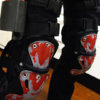Sword Breaker
Member
Its been a long time lads!
Every now and then I see a halo cosplayer in a facebook group and I remember I still want to finish my outfit...
So lately i've been thinking a lot about it, leading me to actually feel worse about what I have completed so far.
My example for this will be my Recon helmet from Reach.
I put love, work, blood, sweat and possibly some tears to make what I have now: (despite an unfortunate experience with the post office that bent the visor out of position) a helmet that I really pride myself on.
And yet, I see so many other amazing works, be it cast in resin or what have you, foam or any other building method and it hurts me because its just sub-par to them. From the shape to the colour and texture, I just feel like its not good enough! And I do realise that everyone starts somewhere but I dont exactly have the ability to keep remaking the helmet till I magically know whats missing...
So to FINALLY get to my point: Since i cant put my finger on exactly whats wrong, how would you, the honestly amazing and inspiring people of 405th, improve this helmet?




Every now and then I see a halo cosplayer in a facebook group and I remember I still want to finish my outfit...
So lately i've been thinking a lot about it, leading me to actually feel worse about what I have completed so far.
My example for this will be my Recon helmet from Reach.
I put love, work, blood, sweat and possibly some tears to make what I have now: (despite an unfortunate experience with the post office that bent the visor out of position) a helmet that I really pride myself on.
And yet, I see so many other amazing works, be it cast in resin or what have you, foam or any other building method and it hurts me because its just sub-par to them. From the shape to the colour and texture, I just feel like its not good enough! And I do realise that everyone starts somewhere but I dont exactly have the ability to keep remaking the helmet till I magically know whats missing...
So to FINALLY get to my point: Since i cant put my finger on exactly whats wrong, how would you, the honestly amazing and inspiring people of 405th, improve this helmet?







